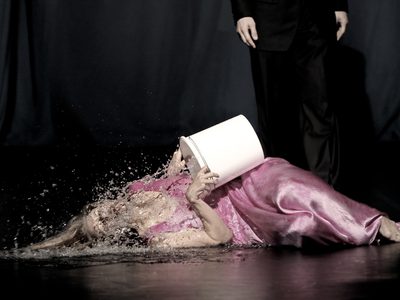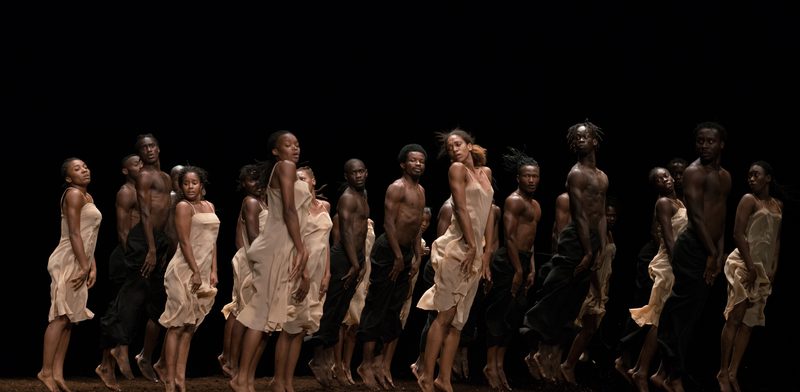
News Story
First things first, what is The Rite of Spring all about?
Nothing too intense, just a ritualistic dance in which one girl is chosen to dance herself to death to celebrate the start of spring – an obvious choice for the season of new life.
The original ballet was choreographed by Vaslav Nijinsky and composed by Igor Stravinsky as a commission from the director of Ballets Russes. The premiere of the performance in Paris in 1913 was so groundbreaking it caused the audience to start a riot. The finer details are debated, but there are reports of audience members shouting so loudly that Stravinsky needed to go into the wings to keep the dancers in time, and the police were called.
Tell me about the music
The sounds of the orchestra pull and push against each other – at times intentionally clashing and at other times beautifully unifying. Time signatures, melodies, rhythms and sections of the orchestra compete throughout, with disturbing and wonderful results.
When writing the music, Stravinsky was inspired by Russian folk tales and his own experiences of spring in Eastern Europe. The opening melody, played on the upper register of the bassoon, is inspired by a Lithuanian folk song.
Although it was shocking at the time, Stravinsky’s work is now recognised as one of the most influential compositions of the century, with many of the controversial elements – irregular rhythms, clashing chords and booming bass lines – now ingrained in contemporary music.
What did it look like?
According to some, the dancing was the cause of most of the uproar that evening. While classical ballet focuses on graceful upwards leaps and bounds, Nijinsky’s choreography pulled the dancers back to the earth. The dancers seemed to jerk, rather than dance, with small jumps, stamping and awkward limb angles.
The costumes were also a departure from ballet tradition, inspired by traditional dress in medieval Russia and from Princess Maria Tenisheva of Russia’s collections of traditional peasant dress. They included long loose dresses with traditional embroidery patterns along the bottom of the skirts, noticeable ballet shoes and ribbons, and the hair was in long, messy plaits, with patterned headpieces.
Who is Pina Bausch?
Pina Bausch was a German dancer and choreographer known for reinventing the dance style Tanztheater, a German word meaning ‘dance theatre’. Bausch took an innovative approach to casting and choreography. She was ‘not interested in how people move, but in what moves them’, selecting dancers based on life experiences and personality. This led to a dance style that had a much freer and more realistic style than classical ballet the audience expected, in many ways following in Nijinsky’s footsteps. Unfortunately, she also had similar experiences with audiences and critics, with one particularly harsh review of her early work stating: ‘The music is very beautiful. You can simply shut your eyes.’.
However, as time moved on, audiences, critics and dancers alike grew to recognise Bausch’s genius, with one dancer, Meryl Tankard, saying Bausch’s technique ‘opened up a whole new world’. Her weaving of real-life experience into her work is now praised for giving her productions an emotional depth and sense of authenticity, particularly as relationships are a central theme in much of her work. Today, Bausch is recognised as one of the most influential choreographers of the 20th century.
Bausch's company, Tanztheater Wuppertal, brought Sweet Mambo to the 2014 International Festival, to critical acclaim, including a five star review from The Guardian: 'a joyous display of artistic exuberance... Exquisite.'
Image gallery
Open an image gallery




So what’s her version of The Rite of Spring about?
Bausch premiered her version of the ballet in 1975, using the same music by Stravinsky but with completely new choreography, retelling the story from the perspective of the victim. In Bausch’s hands, the dance becomes a ‘fable of superstition and misogyny’ rather than simply a depiction of the ritual.
Bausch’s choreography places the emotional journey of the sacrifice in centre stage – quite literally – with the movements beginning to break the dancer down as she violently throws herself into the exhausting sacrificial ritual. Bausch’s production features a soil-covered stage and replaces the intricate traditional costumes with simple white slips, with the costumes becoming increasingly muddied as the ballet goes on. A flash of colour is added in the form of a red dress, passed around on stage to symbolise blood, danger and death. This all combines to create a feeling of frenzied urgency and greater empathy with the female sacrifice.
How did the premiere go?
The world premiere of Bausch’s The Rite of Spring was in December 1975 at Opera House Wuppertal. While there were no riots here, it was only begrudgingly accepted by the more conservative audience in Wuppertal. Meanwhile, it was widely admired by critics, and put Pina Bausch’s company on the European map.
The UK premiere took place at our very own Festival in 1978, the first major showcase for the Tanztheater Wuppertal company outside of Germany. By the time the piece premiered in the United States in 1984, Pina Bausch was beloved. Anna Kisselgoff, for the New York Times wrote about the premiere 'Pina Bausch, from West Germany, is the most talked-about choreographer in Europe and it was obvious that her reputation had preceded her at the Brooklyn Academy of Music last night.'
What does the current production look like?
The production coming to the 2023 Festival features a specially assembled company of over 30 dancers from across 14 African countries. In 2020, the Pina Bausch Foundation (Germany) in conjunction with École des Sables (Senegal) and Sadler’s Wells (UK) recast and restaged the iconic work, complete with the soil-covered stage.
Previously very few dancers from outside the Tanztheater Wuppertal company have had the opportunity to perform Pina’s pieces. An artistic director of this project, Josephine Ann Endicott, says ‘I think it’s a wonderful challenge and a wonderful experience. And the right moment for something like this to happen.’
Where can I buy tickets?
Just in case you need more convincing, check out the critical response to the production:
The choreography is continually unexpected yet feels gut-punchingly inevitable.
The choreography is visceral and atavistic. The final solo is emotive and passionate... [a] stellar performance
[the dancers] bring an energy, commitment and degree of individual authenticity to this iconic work




